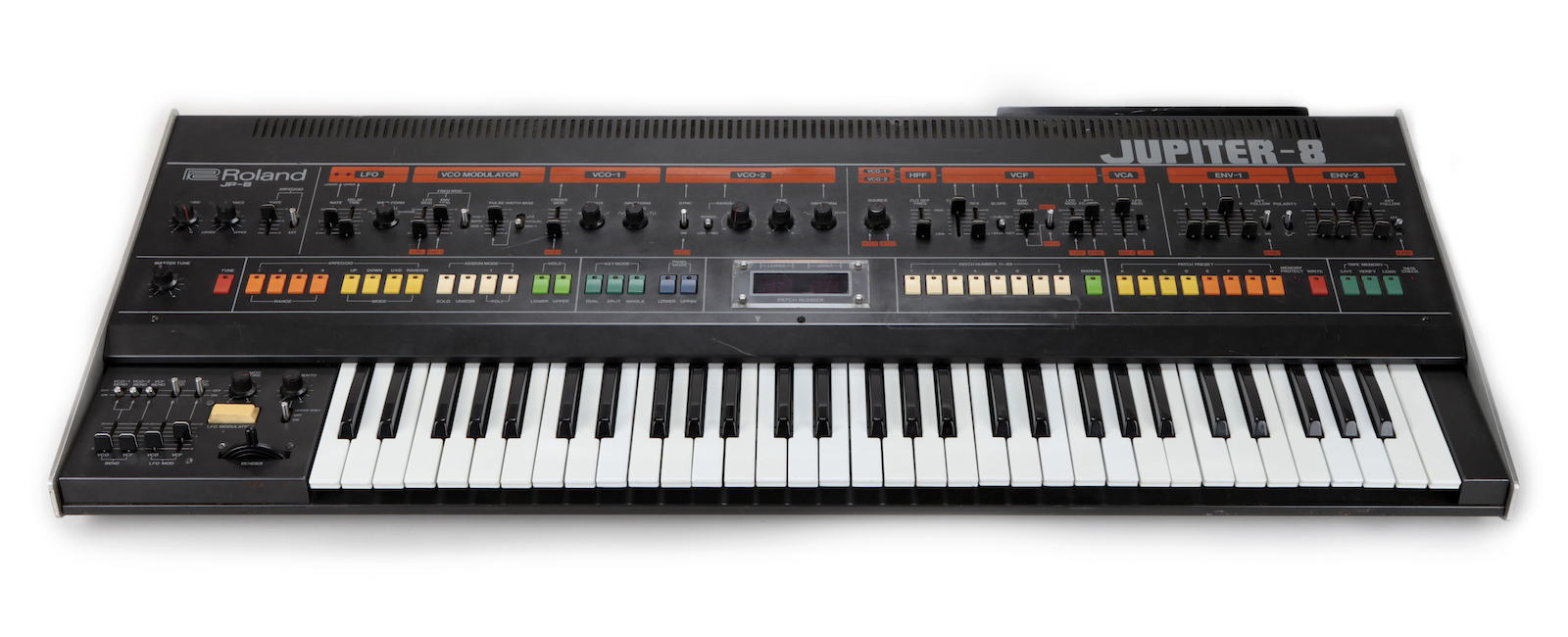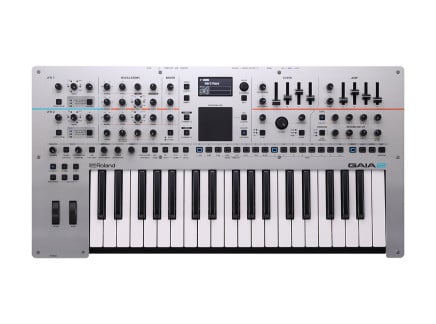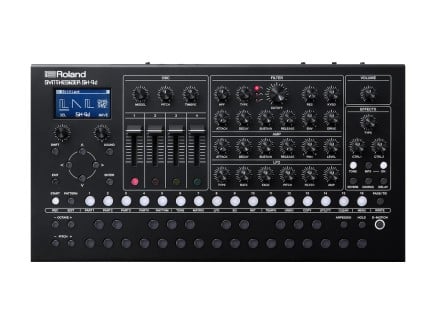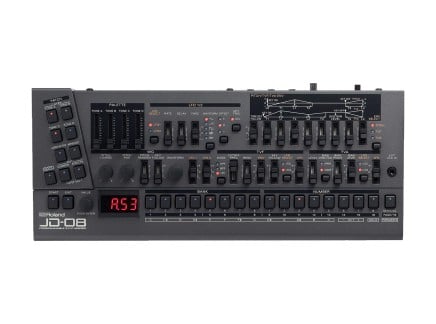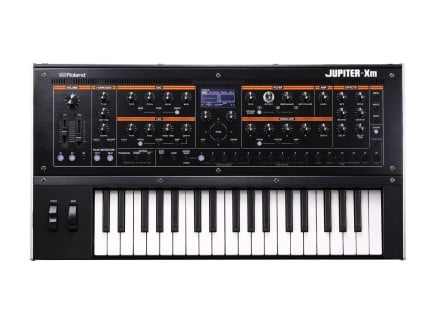Today, Roland introduced the world to their newest synthesizer: the GAIA 2, a fresh reimagining of one of their most popular synthesizers in the past decades. GAIA 2 brings a fresh approach to the table—blending virtual analog with wavetable synthesis, and offering extended expressive potential, a boatload of built-in effects, and upgradeable sound engine.
But...before diving deep into the GAIA 2 itself, let's establish some context. Then we'll take a closer look at what GAIA 2 brings to the table.
Roland at the Dawn of Virtual Analog
Roland is one of the first names you think of when talking about classic polyphonic synthesizers: their original Jupiter and Juno series in many way helped to solidify what many now think of a synthesizer as being altogether—and of course, they helped to solidify the sound that most expect polysynths to make: dreamy ambiences, spiraling arpeggios, and much more.
[Above: the Roland Jupiter-8 and Juno-106—two of the best-loved analog polyphonic synthesizers of all time. Images via Perfect Circuit's archives.]
Of course, eventually the Jupiters and Junos of the '70s and '80s fell out of vogue. Digital synthesizers and samplers became prominent; and shortly thereafter, home computers became a staple part of music-making. DAWs and plugins became the norm. For a while, there was a common attitude that hardware was superfluous, or limiting—and that the computer was a more effective and efficient way to go.
But, all the while, musicians started to vie for what made the analog synths of yesteryear so appealing: their distinct hands-on approach. For many, having real-life knobs, sliders, switches, and keys proved inspirational—and afforded a considerably more intuitive, exploratory approach to synthesizers than was possible with a mouse and QWERTY keyboard alone. And as a result of the attitude that the world needed more hardware synthesizers, many companies started to rethink their approach to synthesizer design...and many new companies came about, introducing modern takes on the synthesis concepts of yesteryear.
At this point, I expect what I'm describing is a familiar story. In the late 1990s and early 2000s, companies like newcomers Clavia/Nord and Access introduced the world to a new method of synthesizer design: one that used digital techniques to model/emulate the behavior of the beloved analog synthesizers from the '70s and '80s. They ushered in the era of Virtual Analog (VA); and soon, other major players took note and made VAs of their own. Soon, the world had all-new, highly tweakable designs from the likes of Alesis, Novation, Korg, Yamaha, and—of course—Roland.
One of the brilliant aspects of VA design is that it was considerably more affordable than producing analog hardware; and it leveraged modern production techniques to produce instruments with 100% consistency. The end result was that new synthesizers weren't just more abundant than ever before—they were also more affordable than ever before to make. As such, new synthesizers started finding their way into completely new user markets—even into the hands of young people who were just getting their start making music altogether.
In the early–mid '00s, we saw a number of companies produce instruments aimed specifically at this market. I, for myself, couldn't afford a Korg MS-2000 in 2002—but I could, for instance, save up enough from my summer job to purchase its nearly-identical-yet-slightly-watered-down sibling, the microKORG. (And in fact, I did!)
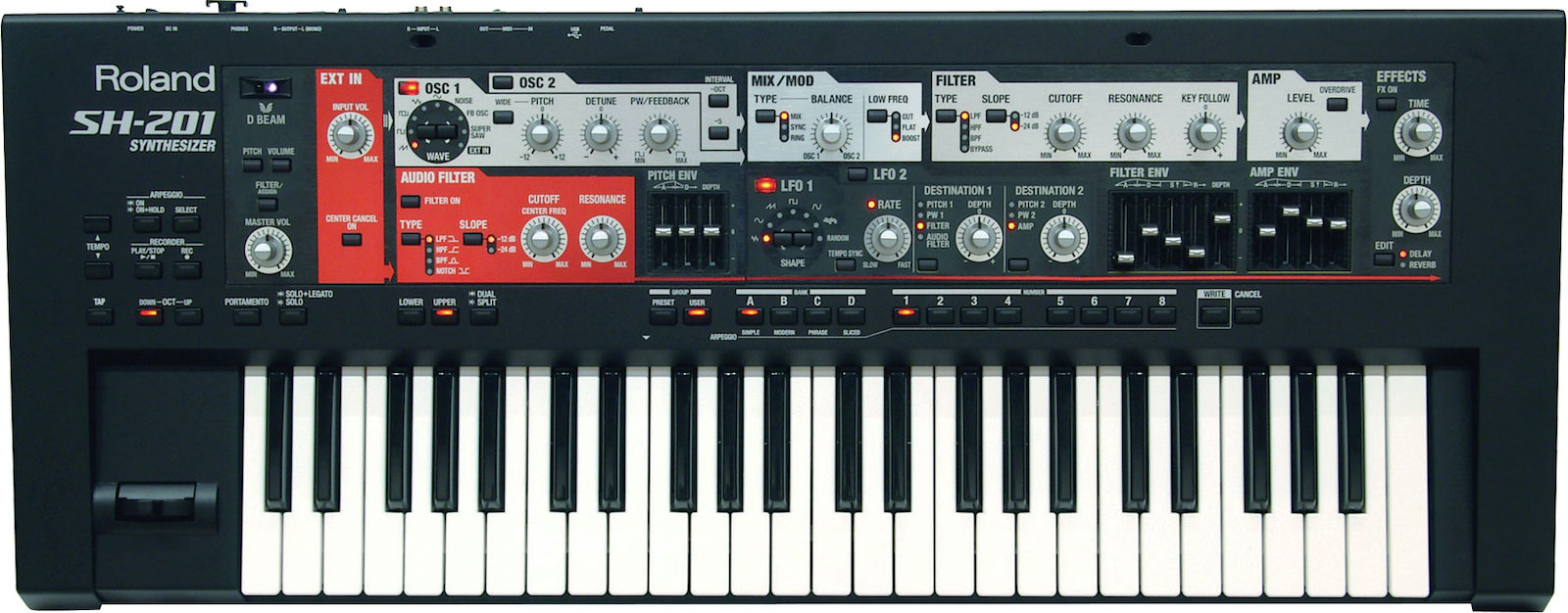
[Above: the Roland SH-201, a virtual analog synthesizer straight out of 2006.]
Roland was among the companies that produced this particular type of synthesizer. 2006's SH-201 resurrected their long-dormant SH series, using a virtual analog sound engine with ten voice polyphony and a full-size, 49-key keybed. This synthesizer was hot: at the time of its release, it presented one of the best features:price ratios of anything else on the market.
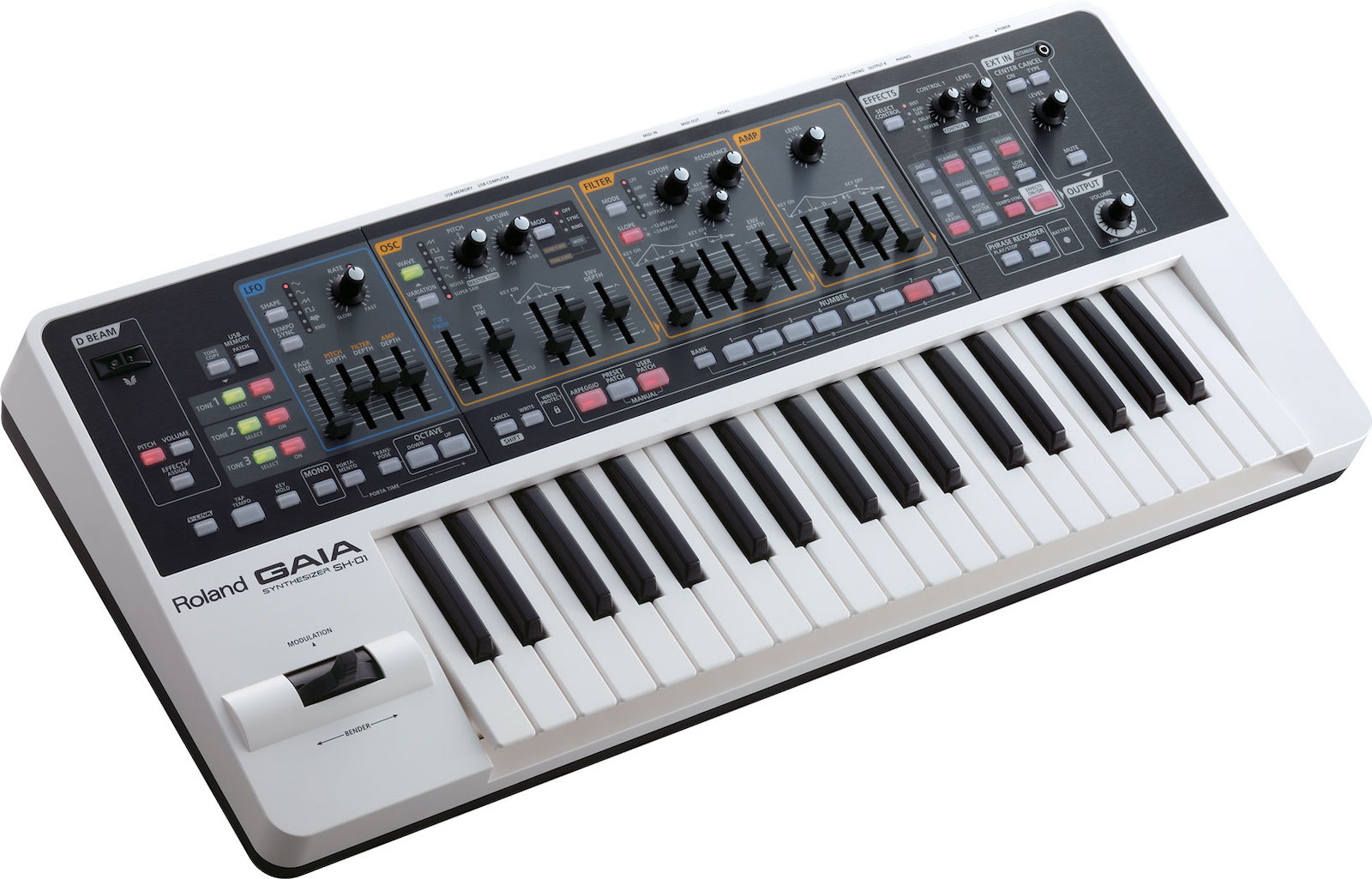
[Above: the Roland GAIA SH-01—one of their most popular synthesizer offerings of the 21st century.]
And then, in 2010, Roland blew it (and most other VAs) out of the water with the tremendously ambitious GAIA SH-01. GAIA SH-01 offered 64 voices of polyphony, 16-part multi-timbral behavior, many integrated effects, phrase recording, a robust arpeggiator, an assignable D-Beam, and a tremendously improved build quality. Moreover, its visual layout was strikingly clear—making it an excellent choice for musicians who were just learning the ropes of "analog" synthesis. It became a common fixture in indie bands, bedroom studios, and in college classrooms...and it remained a tremendously successful instrument for years to follow.
Today, though, Roland introduces its successor. The new GAIA 2 loses the "SH"-associated moniker, but it gains much more: new opportunities for expressive performance, highly detailed means of modulation and control, and a sound engine that incorporates the best of both analog-style and purely digital synthesis. The result? An affordable, fresh-sounding, and quite welcome update to Roland's synthesizer line—filling a long-standing hole in their product lineup. Let's take a look at what it has to offer.
Roland GAIA 2 Virtual Analog / Wavetable Synthesizer
Like many modern synthesizers, GAIA 2 embraces sonic techniques from the past, bringing them into the current era with a streamlined interface that makes exploring new sounds simple and intuitive. In the case of GAIA 2, we're not just looking back at the analog polysynths of the '70s and '80s for inspiration; it also offers all-new wavetable synthesis facilities, perfect for exploring the unique tones and timbres of digital synthesis. Together, this means that GAIA is perfect for combining the lush, vintage tones of analog-style synthesis, as well as the retro-turned-modern sounds of wavetable exploration. The result? Sonic pairings that sound distinct and modern—combining classic elements to create something new. And, like the prior GAIA SH-01, the layout is clean, clear, and easy to understand...making it a solid choice for beginners or anyone who needs to see exactly what knob to reach for on stage.
One of the most notable features in GAIA 2 are its oscillators. Each voice features three oscillators—one wavetable oscillator and two virtual analog oscillators. The wavetable oscillator offers 63 wavetables, which allow for everything from smooth digital morphing to jarring, edgy transitions. This can sound starkly modern, or can hearken back to the vintage wavetable synths of yore—think PPG and Waldorf-style sounds, or, for you DAW-based musicians, imagine getting your hands on a physical version of Serum. That's the area of sound design the wavetable oscillators occupy. You can modulate the wave position, and you'll also get access to phase modulation and shaping modulation, all of which can lead to dynamic, ever-changing timbres.
The virtual analog oscillators, of course, give you access to the most fundamental building blocks of classic analog synth sounds. You'll get sine, triangle, saw, square, and even Roland's classic super saw waveforms...plus five distinct types of noise. You can use shape modulation, ring modulation, oscillator sync, and cross modulation to coax rich, evolving timbres from these unassuming sound sources. So, don't let them fool you; there's much more to them than might immediately meet the eye.
The GAIA 2's filter section offers lowpass, bandpass, and highpass modes at a variety of slopes; like many keyboard synths, GAIA 2 features a dedicated ADSR envelope generator for controlling timbral articulations. Additionally, you have access to filter drive...coaxing enormous sounds even from the simplest incoming waveforms. The amp section, like the filter, has a dedicated ADSR envelope for creating articulation.

Modulation in GAIA 2 can be quite complex. In addition to the filter and amp envelopes, you have a general-purpose AD modulation envelope, which can be assigned to a wide variety of destinations—from wavetable position to VA oscillator shape, phase or shape modulation depth, and more. You also get two LFOs with five waveforms and a programmable step wave; each LFO can be assigned to up to four parameters across the synth engine.
At the end of the signal chain, there is a robust effect processor, with 53 types of mult-effects, seven types of reverb/delay, and three types of chorus—and the order of these effect types can be changed at will. This contains everything from straightahead delays and reverbs to an all-new shimmer reverb and Roland's infamous granular glitch effect, Scatter; great for everything from establishing a sense of space to extensive performative control. You'll also get a master EQ and compressor for end-of-chain signal shaping.
But the sound engine itself is only part of what GAIA 2 offers. It also offers a significant amount of control over its sounds. The envelopes and LFOs are one thing, but there's much more to it than that. You get the standard pitch bend and modulation wheels, as well as an arpeggiator with multiple modes and 16 scale variations. You'll also get a step sequencer with up to 64 steps—each of which can record eight notes and four panel controls. That means that you can have different settings for your sound on each step, leading to sequences with surprising complexity and plenty of opportunity for surprise. It supports real-time, step, and TR-REC recording, allowing many means of programming and control for everything from meticulously planned detail to happy accidents. You also get access to controls for probability and random pattern generation, opening up even more opportunities for variation and sonic evolution.
Of course, one of the most attention-grabbing features of the GAIA 2 is the all-new Motional Pad. This X/Y touch surface sits right below the main screen, and can be assigned to any panel knobs or sliders...so you can easily take hands-on control of multiple parameters at once. You can also record your movements on the Motional Pad and play them back...so, you can think of it as something like a multi-dimensional, user-definable LFO for any of the synth's main parameters. What would that sound like? That's entirely up to you to decide—but the major takeaway here is that GAIA 2 offers an uncommon level of control for an instrument of its price.
And yet, there's much more to GAIA 2 than all that. Like other Roland instruments, GAIA 2 supports Roland Model Expansions—so you can add the sound and behavior of countless Roland classic instruments. In fact, GAIA 2 ships with the SH-101 Model Expansion pre-installed. Yep, that's right...in addition to everything we've described, GAIA 2 can act like a polyphonic SH-101 right out of the box. Additional model expansions can be purchased through Roland Cloud; so you can easily turn your GAIA 2 into a Jupiter-8, Juno-106, and more. The control layout will be automatically mapped to the correct parameters, so you can get straight to tweaking for vintage-style tones.
GAIA 2 in Review

There are, of course, other keyboard synths in GAIA 2's price range—but in our opinion, few if any present quite the same value proposition. GAIA 2 is, first and foremost, and affordable and approachable instrument for anyone who needs quick and easy access to a huge range of classic analog-esque or contemporary digital sounds. You don't need a deep understanding of synthesis to take advantage of its strengths; it will prove an excellent tool for learning the ins and outs of synthesizers, and will give you an endless supply of interesting and inspiring sounds along the way. Its combination of approachability and affordability is a unique offering—one that we expect will cement its place as one of the most important commercial keyboard synthesizers of the 2020s.
So, if you're looking for an instrument that cuts through the fluff and gets you straight to making fun, inspiring, and fresh sounds—GAIA 2 is well worth a look. Whether you're just starting out or looking for a new tool for your studio or stage setup, it should be on your radar.

